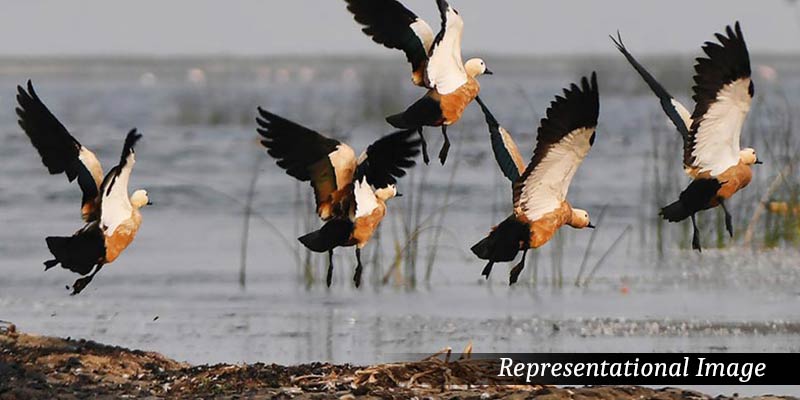- India
- Jun 06
- Sreesha V.M
Rajasthan’s Khichan, Menar wetlands added to Ramsar list
• Two more sites from India have been added to the list of wetlands of international importance, taking the number of such sites in the country to 91.
• The latest to join the list of Ramsar Sites in India are Khichan in Phalodi and Menar in Udaipur, both in Rajasthan.
Khichan Wetland
• Khichan Wetland, located in the northern Thar Desert, comprises two water bodies — Ratri nadi (river) and Vijaysagar talab (pond) — riparian habitat and scrub land. This desert ecosystem supports drought-resistant plant species that provide habitat for over 150 species of birds.
• The Khichan wetland represents a sustainable human-wildlife co-existence within desert ecosystems.
• The Site is especially recognised for hosting large wintering flocks of migratory demoiselle cranes (Anthropoides virgo), making up over 22,000 individuals each year.
• Residents of the adjacent village work to mitigate threats to the cranes’ survival, by reducing mortalities from power line collisions and stray dog attacks.
• The Site attracts bird-watchers, tourists, students and scientists, drawn primarily by the large seasonal gathering of the cranes.
Menar Wetland Complex
• Menar Wetland Complex in Rajasthan is a freshwater monsoon wetland complex formed by three ponds — Braham talab, Dhand talab and Kheroda talab, and agricultural land that connects the latter two.
• During the monsoon season the farmland floods, providing habitat for 110 species of waterbirds, of which 67 are migratory.
• Among the notable bird species at the Site are the critically endangered white-rumped vulture (Gyps bengalensis) and long-billed vulture (Gyps indicus).
• Over 70 plant species are found, including mango trees (Mangifera indica) around Braham talab that host a large colony of Indian flying fox (Pteropus giganteus).
• The Site is recognised as one of the best examples of community-led conservation in Rajasthan, with residents of the nearby Menar village playing a key role in conserving wildlife by preventing poaching or fishing.
What is the Ramsar Convention?
• The Ramsar List is the world’s largest network of protected areas. There are over 2,500 Ramsar Sites, covering more than 2.5 million square kilometres.
• The Ramsar Convention is an international treaty signed by 172 countries to protect wetlands.
• It is named after the city in Iran where it was signed, and it began with 18 countries in 1971.
• The convention is one of the oldest inter-governmental accords for preserving the ecological character of wetlands. Also known as the Convention on Wetlands, it aims to develop a global network of wetlands for the conservation of biological diversity and for sustaining human life.
• It is one of the largest international agreements, after the Convention on Biological Diversity (CBD, 196 countries) and the UN climate agreement (UNFCCC, 197 countries).
• India ratified the convention on February 1, 1982.
• The first Site was the Cobourg Peninsula in Australia, designated in 1974. The largest Sites are Rio Negro in Brazil (120,000 sq km), and Ngiri-Tumba-Maindombe in the Democratic Republic of Congo and Queen Maud Gulf in Canada. These Sites each cover over 60,000 sq km.
• The countries with the most Sites are the United Kingdom with 176 and Mexico with 144. Brazil has the largest area with 267,000 square km under the Convention protection; Bolivia, Canada, Chad, Congo, the Democratic Republic of Congo and the Russian Federation have also each designated over 100,000 square km.
• Saudi Arabia deposited its instrument of accession to the Convention with the Director-General of UNESCO. The Convention will enter into force for the country on August 2, 2025, making it the treaty’s 173rd Contracting Party dedicated to the conservation and wise use of wetlands.
What are wetlands?
• Wetlands are ecosystems where water is the primary factor controlling the environment and the associated plant and animal life.
• Wetlands are land areas that are saturated or flooded with water either permanently or seasonally. Inland wetlands include marshes, ponds, lakes, fens, rivers, floodplains and swamps.
• Coastal wetlands include saltwater marshes, estuaries, mangroves, lagoons and even coral reefs. Fish ponds, rice paddies and saltpans are man-made wetlands.
• Wetlands provide a wide range of important resources and ecosystem services such as food, water, fibre, groundwater recharge, water purification, flood moderation, erosion control and climate regulation.
• They are, in fact, a major source of water and our main supply of freshwater comes from an array of wetlands which help soak rainfall and recharge groundwater.
• Though they cover only around 6 per cent of the Earth’s land surface, 40 per cent of all plant and animal species live or breed in wetlands.
• Wetland biodiversity matters for our health, our food supply, for tourism and for jobs. Wetlands are vital for humans, for other ecosystems and for our climate, providing essential ecosystem services such as water regulation, including flood control and water purification.
• More than a billion people across the world depend on wetlands for their livelihoods – that’s about one in eight people on Earth.
• Every year, February 2 is observed as World Wetlands Day to raise global awareness about the vital role of wetlands for our planet. This day also marks the date of the adoption of the Convention on Wetlands on February 2, 1971, in Ramsar, Iran.
(The author is a trainer for Civil Services aspirants.)


